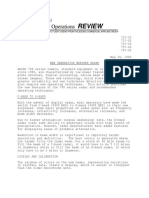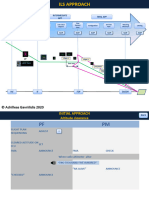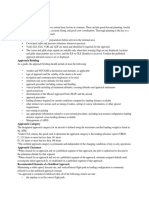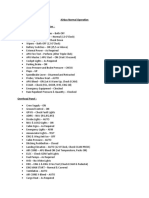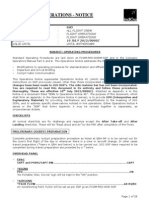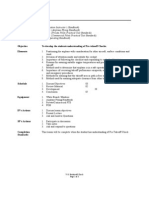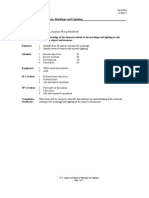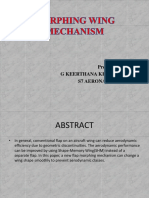Secondary Stalls
Secondary Stalls
Uploaded by
Mike AguirreCopyright:
Available Formats
Secondary Stalls
Secondary Stalls
Uploaded by
Mike AguirreCopyright
Available Formats
Share this document
Did you find this document useful?
Is this content inappropriate?
Copyright:
Available Formats
Secondary Stalls
Secondary Stalls
Uploaded by
Mike AguirreCopyright:
Available Formats
IX.
Secondary
Stalls_____________________________________________________________
References:
1. AC 60-14 (Aviation Instructor’s Handbook)
2. FAA-H-8083-3 (Airplane Flying Handbook)
3. FAA-S-8081-1 (Private Pilots Practical Test Standards)
4. FAA-S-8081-2 (Commercial Pilots Practical Test Standards)
5. POH (Pilots Operating Handbook)
Objective To develop the CFI student’s understanding of Secondary Stalls.
Elements 1. Aerodynamics of secondary stalls.
2. Flight situations where a secondary stall may occur.
3. Hazards of secondary stalls during normal stall or spin recovery.
4. Entry technique and minimum entry altitude.
5. Recognition of a secondary stall.
6. Recovery technique and minimum recovery altitude.
Schedule 1. Discuss Objectives 03
2. Review Material 02
3. Development 20
4. Conclusion 05
Equipment 1. White Board / Markers
2. Airplane Flying Handbook
3. Private/Commercial PTS
4. POH
IP’s Actions 1. Discuss lesson objectives
2. Present Lecture
3. Ask and Answer Questions
SP’s Actions 1. Participate in discussion
2. Take notes
3. Ask and respond to questions
Completion This lesson will be complete when the CFI student has understanding of Secondary
Standards Stalls.
IX.E. Secondary Stalls
Page 1 of 3
Instructor’s Notes: Secondary Stalls________________________________________________
INTRODUCTION:
WHAT? – The secondary stall may occur after a recovery from a preceding primary stall. It is caused by
attempting to hasten the completion of a stall recovery before the airplane has regained sufficient flying speed.
WHY? – The objective of this demonstration maneuver is to show what can happen when the pilot becomes too
anxious to return to straight and level flight after a stall or spin recovery
OVERVIEW - This lesson will cover the basic elements pertaining to Secondary Stalls, including:
1. Aerodynamics of secondary stalls.
2. Flight situations where a secondary stall may occur.
3. Hazards of secondary stalls during normal stall or spin recovery.
4. Entry technique and minimum entry altitude.
5. Recognition of a secondary stall.
6. Recovery technique and minimum recovery altitude.
DEVELOPMENT:
HOW?
1.) AERODYNAMICS OF A STALL
A.) A stall is a loss of lift and an increase in drag occurring when an aircraft is flown at an angle of attack
greater than the angle for maximum lift - - exceeding the critical angle of attack.
B.) Critical angle of attack - When the angle of attack is increased to approximately 18 to 20 degrees, the air-
stream can no longer follow the upper curvature of the wing because of an excessive change in direction.
C.) A STALL CAN OCCURE AT ANY AIRSPEED, ATTITUDE, AND POWER SETTING!
D.) Airflow begins to separate as it is forced to flow straight back and swirls as it attempts to follow the
upper wing surface.
1. This causes a sudden increase in pressure on the upper wing surface causing a considerable loss of
lift.
E.) Most wings are designed to stall at the wing root first, then out to the wing tips.
1. Because the wingtip has a lower angle of incidence that the wing root
F.) Recoveries from stalls and spins involve a tradeoff - a loss of altitude (and an increase in airspeed) Vs. an
increase in load factors in the pull-up.
1. If the airspeed is less that the stall speed, the airplane will enter a secondary stall.
2. In addition, the increased load factors increase the stall speed.
2.) FLIGHT SITUATIONS IN WHICH SECONDARY STALLS MAY OCCUR
A.) When a stall surprises the pilot causing him to hurry through the stall recovery.
3.) HAZARDS OF SECONDARY STALLS
A.) Significant load factor increases are sometimes induced during pull-up from a stall or stall
1. These can result in structural damage, especially if stall above maneuvering speed.
4.) SIMULATING THE MANEUVER
A.) Pre-maneuver check
B.) Clearing turn
C.) Entry altitude - recover above 1,500 AGL or manufacturer recommended.
D.) Induce Power-Off Stall.
E.) Initiate stall recovery without adding power
F.) Immediately pitch up to 10 degrees.
G.) Secondary stall should follow after first stall indication
IX.E. Secondary Stalls
Page 2 of 3
H.) RECOVER
1. Reduce angle of attack - allow wing to regain lift.
2. Apply full power
3. Stop any rotation with opposite rudder
4. Slowly pitch to Vy attitude
5. Retract flaps to half.
6. After positive rate of climb, retract gear.
7. Accelerating through Vx, retract remaining flaps.
8. Recover to cruise.
5.) RECOGNITION OF SECONDARY STALLS
A.) Indications include buffeting, loss of control effectiveness, full-up elevator, high sink rate, and nose-
down pitching.
COMMON ERRORS:
1. Failure to establish selected configuration prior to entry.
2. Improper or inadequate demonstration of the recognition of and recovery from
3. a secondary stall.
4. Failure to establish a condition that will cause a secondary stall to occur.
5. Failure to present simulated student instruction that adequately emphasizes the hazards of poor technique in
recovering from a primary stall.
CONCLUSION
OVERVIEW
Discuss Elements, to include:
1. Aerodynamics of secondary stalls.
2. Flight situations where a secondary stall may occur.
3. Hazards of secondary stalls during normal stall or spin recovery.
4. Entry technique and minimum entry altitude.
5. Recognition of a secondary stall.
6. Recovery technique and minimum recovery altitude.
PRIVATE PTS
As Stated
COMMERCIAL PTS
As Stated
IX.E. Secondary Stalls
Page 3 of 3
You might also like
- Airbus PDP Rops PDFDocument4 pagesAirbus PDP Rops PDFAnders MardNo ratings yet
- Paragliding Training GuideDocument24 pagesParagliding Training Guideyannickd100% (6)
- SLF Discussion Item NotesDocument67 pagesSLF Discussion Item Notesvidur bangiaNo ratings yet
- Exercise 4 Effects of ControlsDocument58 pagesExercise 4 Effects of Controlss raman100% (2)
- F1 Cars Seminar ReportDocument24 pagesF1 Cars Seminar ReportPrince Arora0% (1)
- Spar LocationDocument4 pagesSpar LocationParth ChopraNo ratings yet
- Complete Answers - Physics Form 5 TBDocument36 pagesComplete Answers - Physics Form 5 TBAlexandra Chieng83% (6)
- Design and Analysis of Aircraft WingDocument7 pagesDesign and Analysis of Aircraft WingSai RahulNo ratings yet
- Airman Certification Standards: Commercial Pilot - Helicopter (2025): FAA-S-ACS-16From EverandAirman Certification Standards: Commercial Pilot - Helicopter (2025): FAA-S-ACS-16No ratings yet
- Airbus A320 Simulator Flight: Preparation and Lecture For DACP ScreeningDocument162 pagesAirbus A320 Simulator Flight: Preparation and Lecture For DACP ScreeningJP Zemog100% (1)
- Visual Descent Point (VDP)Document4 pagesVisual Descent Point (VDP)gambit_zetaNo ratings yet
- A320 Stall RecoveryDocument3 pagesA320 Stall RecoverylahirishrayanNo ratings yet
- Landing ConsiderationDocument4 pagesLanding ConsiderationАлександр ОрловNo ratings yet
- Operational ProceduresDocument111 pagesOperational ProceduresJames MwamuyeNo ratings yet
- Additional Study GuideDocument15 pagesAdditional Study GuideAmine ChabchoubNo ratings yet
- Communication Failure ProcedureDocument6 pagesCommunication Failure Procedureeak_ya5875No ratings yet
- A320 Memory ItemsDocument9 pagesA320 Memory ItemsAdebayo KehindeNo ratings yet
- 737-02 Weather Radar PDFDocument5 pages737-02 Weather Radar PDFtkwstas797938No ratings yet
- Contingency Procedures NAT RegionDocument4 pagesContingency Procedures NAT RegionflyspannerrNo ratings yet
- 050 - 2019-10-18 CH 02 03 06 10 ExamDocument20 pages050 - 2019-10-18 CH 02 03 06 10 ExamNicolas CuvelierNo ratings yet
- Ultimate Airline SelectionDocument112 pagesUltimate Airline Selectionqwgcdffm2f100% (1)
- Leh Airport GuideDocument21 pagesLeh Airport GuideRakshit DholariaNo ratings yet
- 335 A320 Landing PerformanceDocument14 pages335 A320 Landing Performancepietrovolare79100% (1)
- Hight Altitude Airport OperationsDocument2 pagesHight Altitude Airport OperationsMatthew 19No ratings yet
- Climb Performance Et Al - Lecture #3Document155 pagesClimb Performance Et Al - Lecture #3Bruce100% (1)
- © Achilleas Gavriilidis 2020: Initial App Intermediate APP Final AppDocument29 pages© Achilleas Gavriilidis 2020: Initial App Intermediate APP Final AppAngelos Tzortzis100% (1)
- IncapacitationDocument4 pagesIncapacitationCaptain MorganNo ratings yet
- Competency-Based Uprt ProgrammesDocument10 pagesCompetency-Based Uprt ProgrammesAmgad Kamel MarzoukNo ratings yet
- A320-X Introduction GuideDocument37 pagesA320-X Introduction GuidecarlosjricoNo ratings yet
- 032 - Flight Performance and PlanningDocument4 pages032 - Flight Performance and PlanningUvin RanaweeraNo ratings yet
- BriefingDocument4 pagesBriefingTural Hasanov100% (1)
- Unreliable AirspeedDocument10 pagesUnreliable AirspeedSajneesh SharmaNo ratings yet
- 737 Immediate Action Items (RED QRC)Document2 pages737 Immediate Action Items (RED QRC)Phil100% (1)
- Oceanic ChecklistDocument2 pagesOceanic ChecklistJose MaiaNo ratings yet
- Notes For FCTMDocument10 pagesNotes For FCTMAmun RaNo ratings yet
- Fuel Penalty PresentationDocument18 pagesFuel Penalty PresentationSami SlimNo ratings yet
- Radio Navigation: Use of VOR: IFR Briefing I3Document75 pagesRadio Navigation: Use of VOR: IFR Briefing I3Sandeep JangraNo ratings yet
- Boeing Bullettin On Stall and RecoveryDocument7 pagesBoeing Bullettin On Stall and RecoveryDavid Kress-ChengNo ratings yet
- Airbus Normal ProceduresDocument7 pagesAirbus Normal ProceduresLandy FebriansyahNo ratings yet
- A320 Emergency BriefingDocument1 pageA320 Emergency BriefingSHANTNOO RATHODNo ratings yet
- Circling Approach 2 Eng 4Document1 pageCircling Approach 2 Eng 4porcotNo ratings yet
- A 0 Engine Failure in CruiseDocument1 pageA 0 Engine Failure in CruiseChris Markert-BourdonNo ratings yet
- Rejected Takeoff On Slippery Runway PDFDocument12 pagesRejected Takeoff On Slippery Runway PDFGirish SreeneebusNo ratings yet
- 08ATSBL01 - Oceanic ChecklistDocument7 pages08ATSBL01 - Oceanic ChecklistpedatiNo ratings yet
- Proper Landing TechniqueDocument2 pagesProper Landing Techniqueanshit1No ratings yet
- A320 Technical NotesDocument118 pagesA320 Technical NotesMiran Mir50% (2)
- Cyle 6 Winter 2.0 PDFDocument70 pagesCyle 6 Winter 2.0 PDFJavier Castaños RuizNo ratings yet
- LPJ Operational ProceduresDocument90 pagesLPJ Operational ProceduresmuratNo ratings yet
- Failure ManagmentDocument2 pagesFailure ManagmentVan Loock Bart100% (1)
- Operations Notice 04D Operating Procedures 307k12Document28 pagesOperations Notice 04D Operating Procedures 307k12Rohit Lamba100% (1)
- Boeing 737-700 Performance and Selected Limitations CFM56-7B20Document11 pagesBoeing 737-700 Performance and Selected Limitations CFM56-7B20Ronaldo PongaNo ratings yet
- UPRT - Aerodynamic Principles of Large Airplane Upsets MAR 16Document14 pagesUPRT - Aerodynamic Principles of Large Airplane Upsets MAR 16Sacha MilovanNo ratings yet
- Drift Correction in The HoldDocument4 pagesDrift Correction in The HoldmartNo ratings yet
- A320 Max Altitude PDFDocument19 pagesA320 Max Altitude PDFallex_nathanielNo ratings yet
- Airbus - Briefing Guide - 29 Aug 2019Document18 pagesAirbus - Briefing Guide - 29 Aug 2019nodynarenNo ratings yet
- 180° Turns On RunwayDocument9 pages180° Turns On RunwaybilelNo ratings yet
- Threat and Error Management RTCDocument9 pagesThreat and Error Management RTCmicheleNo ratings yet
- ATC Deviation Issues in The Nicosia FIR: 11ATSBL01Document2 pagesATC Deviation Issues in The Nicosia FIR: 11ATSBL01Artem RassokhaNo ratings yet
- Emergency DescentDocument16 pagesEmergency DescentSami SlimNo ratings yet
- 5 Rules-Of-Thumb Every Pilot Should Know BoldmethodDocument1 page5 Rules-Of-Thumb Every Pilot Should Know BoldmethodOu FeiNo ratings yet
- Differential Pressure Vertical Speed: Its Components Are As FollowsDocument4 pagesDifferential Pressure Vertical Speed: Its Components Are As Followsajaydce05No ratings yet
- Turns Around A Point LessonDocument4 pagesTurns Around A Point LessonMike Aguirre100% (1)
- SKBO Charts (Dragged)Document1 pageSKBO Charts (Dragged)Mike AguirreNo ratings yet
- Pre Takeoff CheckDocument3 pagesPre Takeoff CheckMike AguirreNo ratings yet
- Federal Aviation RegulationsDocument3 pagesFederal Aviation RegulationsMike AguirreNo ratings yet
- Operation of SystemsDocument2 pagesOperation of SystemsMike AguirreNo ratings yet
- Airplane Weight and BalanceDocument3 pagesAirplane Weight and BalanceMike Aguirre100% (2)
- Airport and Runway Markings and LightingDocument4 pagesAirport and Runway Markings and LightingMike Aguirre100% (1)
- Short-Field Approach and LandingDocument4 pagesShort-Field Approach and LandingMike Aguirre100% (1)
- Cross - Controlled StallsDocument3 pagesCross - Controlled StallsMike AguirreNo ratings yet
- Elevator Trim StallsDocument3 pagesElevator Trim StallsMike Aguirre100% (2)
- Fundamentals of InstructingDocument6 pagesFundamentals of InstructingMike AguirreNo ratings yet
- Systems and Equipment MalfunctionsDocument5 pagesSystems and Equipment MalfunctionsMike Aguirre100% (1)
- Engine StartingDocument3 pagesEngine StartingMike AguirreNo ratings yet
- Radio Communications and ATC Light SignalsDocument4 pagesRadio Communications and ATC Light SignalsMike Aguirre100% (1)
- Logbook Entries and Certificate EndorsementsDocument3 pagesLogbook Entries and Certificate EndorsementsMike Aguirre100% (2)
- Emergency Equipment and Survival GearDocument3 pagesEmergency Equipment and Survival GearMike Aguirre100% (2)
- Lazy EightsDocument3 pagesLazy EightsMike Aguirre100% (1)
- El Gavilan 358Document12 pagesEl Gavilan 358EduardoFadulNo ratings yet
- Drag Reduction PossibilitiesDocument5 pagesDrag Reduction PossibilitiesYvessNo ratings yet
- Aerodynamics Mock Board 1Document5 pagesAerodynamics Mock Board 1Yenoh SisoNo ratings yet
- Morphing Wing MechanismDocument16 pagesMorphing Wing MechanismG KEERTHANA KRISHNANNo ratings yet
- Aerodynamic DragDocument486 pagesAerodynamic Draggswicke gmailNo ratings yet
- Design of A High Altitude Fixed Wing Mini UAV - Aerodynamic ChallengesDocument8 pagesDesign of A High Altitude Fixed Wing Mini UAV - Aerodynamic ChallengesyousefNo ratings yet
- Class ProjectDocument7 pagesClass ProjectSebastián Obregón RomeroNo ratings yet
- Guerrero Vela ETSIDocument11 pagesGuerrero Vela ETSIKarthik KrNo ratings yet
- Mea97 2Document502 pagesMea97 2Nurul Fitri FathiaNo ratings yet
- Raymer ADACA6 UploadForResearchGateDocument9 pagesRaymer ADACA6 UploadForResearchGateTarik Hassan ElsonniNo ratings yet
- Proadvice 2 - The Wing PlanformDocument7 pagesProadvice 2 - The Wing PlanformHemesh AceNo ratings yet
- Final Report On OptimisationDocument75 pagesFinal Report On OptimisationRaman BaluNo ratings yet
- Airplane DesignDocument34 pagesAirplane DesignMarion Nori MarallagNo ratings yet
- Aerodynamics AssignmentDocument1 pageAerodynamics AssignmentgydtfgNo ratings yet
- Department of Mechanical EngineeringDocument58 pagesDepartment of Mechanical EngineeringStanPuneetNo ratings yet
- 3 Forces&Pressure T PDFDocument47 pages3 Forces&Pressure T PDFnyshahidaNo ratings yet
- Real-Time Modeling of Agile Fixed-Wing UAV Aerodynamics: June 2015Document9 pagesReal-Time Modeling of Agile Fixed-Wing UAV Aerodynamics: June 2015Ulisses CasemiroNo ratings yet
- Brazier LoadsDocument12 pagesBrazier LoadsManoj ManoharanNo ratings yet
- Basic Aerodynamics Revised EditionDocument108 pagesBasic Aerodynamics Revised EditionRushav Samant100% (1)
- Title of Manuscript (Capital Letter of Each Word) : Journal of Advanced Research in Fluid Mechanics and Thermal SciencesDocument3 pagesTitle of Manuscript (Capital Letter of Each Word) : Journal of Advanced Research in Fluid Mechanics and Thermal SciencesRN Builder IpohNo ratings yet
- Co2 Dragsters Research FolioDocument19 pagesCo2 Dragsters Research Folioapi-299008285100% (1)
- Aerodynamics of Race CarsDocument39 pagesAerodynamics of Race CarsGrouchoMarx04100% (1)
- Aerodynamic Design and CFD Analysis of Wing Fuselage Junction For High Performance SailplaneDocument23 pagesAerodynamic Design and CFD Analysis of Wing Fuselage Junction For High Performance SailplaneRachana R PatankarNo ratings yet
- Co L, NP, AC, CGDocument8 pagesCo L, NP, AC, CGAnuj AroraNo ratings yet


















